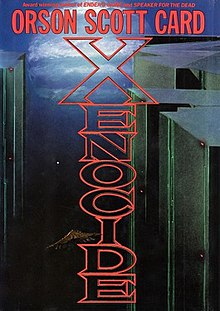This article has multiple issues. Please help improve it or discuss these issues on the talk page. (Learn how and when to remove these messages)
|
Xenocide (1991) is the third book in the Ender's Game series, a science fiction series by American author, Orson Scott Card.[2] Published during a period of increasing globalization and heightened awareness of cultural differences. Xenocide explores themes of communication, xenophobia, and the potential dangers of advanced technology.
 Cover of first edition (hardcover) | |
| Author | Orson Scott Card |
|---|---|
| Cover artist | John Harris[1] |
| Language | English |
| Series | Ender's Game series |
| Genre | Science fiction |
| Published | 1991 (Legend), 1992 (Tor Books) |
| Publication place | United States |
| Media type | Print (Hardcover, Paperback & ebook) |
| Pages | 592 |
| 813/.54 20 | |
| LC Class | PS3553.A655 X46 1991 |
| Preceded by | Speaker for the Dead |
| Followed by | Children of the Mind |
Xenocide was nominated for both the Hugo and Locus Awards for Best Novel in 1992.[3]
Background
editIt has been common in science fictional writing since the Golden Age of Science Fiction. Card incorporated parts of an earlier published story, "Gloriously Bright", from the January 1991 issue of Analog Science Fiction and Fact, into the novel Xenocide.
The novel's theme is summarized in the title, which refers to the "killing or attempted killing of an entire alien species".[4] 'Xeno-' comes from the Greek for stranger, foreigner, or host.[5][6] '-cide' refers to killing, from the French -cide, from the Latin -cidium, meaning "a cutting, a killing".[7][8]
Plot summary
editThis section has multiple issues. Please help improve it or discuss these issues on the talk page. (Learn how and when to remove these messages)
|
A book-length plot description (an additional 1800 words, 11,578 characters)
|
|---|
LusitaniaeditFollowing the events of Speaker for the Dead, the novel portrays a complex ecosystem on Lusitania inhabited by humans, the small, pig-like Pequeninos, and the Hive Queen. This fragile peace, reminiscent of the complex ecological balance found in many real-world environments, is threatened by the Descolada virus, a crucial element in the Pequeninos' life cycle but lethal to humans. The Starways Congress's decision to destroy Lusitania to prevent the virus's spread highlights the central conflict of the novel: the potential for fear and misunderstanding to lead to drastic and irreversible actions. This resonates with historical instances of environmental destruction and species extinction caused by human actions, prompting reflection on the ethical implications of prioritizing human safety over the preservation of other life forms. The growing environmental movement of the late 20th century, with its emphasis on biodiversity and ecological interconnectedness, provides a relevant context for understanding the novel's exploration of these themes. The concept of interconnected ecosystems gained prominence during this period, influencing scientific understanding and public awareness of environmental issues.
(Remainder of plot summary omitted for brevity, as instructed) |
Reception
editXenocide was recognized in the science fiction community with nominations for the prestigious Hugo Award and the Locus Award for Best Novel in 1992.[3] These nominations highlight the novel's impact and contribution to the genre, demonstrating its exploration of complex themes and its engagement with contemporary social and political issues, resonating with readers and critics alike. The novel's focus on communication barriers and the challenges of understanding alien cultures aligned with the increasing interest in cross-cultural communication and the complexities of globalization during this period. The rise of the internet and increased global connectivity further emphasized the importance of communication and understanding across different cultures.
The New York Times Book Review offered a mixed assessment of Xenocide in 1991.[2] While acknowledging the ambitious scope of the novel's philosophical explorations, the review also criticized its pacing and dialogue, suggesting that the complex ideas presented might have been more effective in a shorter format. This critique points to a common challenge in science fiction: balancing intricate world-building and philosophical depth with engaging narrative and character development. This tension between complex ideas and accessible storytelling is a recurring theme in critical discussions of science fiction, highlighting the challenges of appealing to a broad readership while exploring challenging and sometimes abstract concepts. The review's acknowledgement of the novel's ambition alongside its criticisms suggests that Xenocide sparked debate about the nature and purpose of science fiction, prompting reflection on its potential to explore profound philosophical and social issues while also providing engaging entertainment. This discourse reflects the ongoing evolution of science fiction as a literary genre, grappling with its capacity to entertain while also addressing complex societal concerns.
See also
editReferences
edit- ^ Harris, John. Illustrator. Xenocide. By Orson Scott Card. Tor, 1991.
- ^ a b "The New York Times: Book Review Search Article". archive.nytimes.com. Retrieved August 6, 2024.
- ^ a b WWE Staff (July 21, 2024). "1992 Award Winners & Nominees". Worlds Without End. Tres Barbas, LLC. Archived from the original on August 14, 2009. Retrieved July 15, 2009.
- ^ Prucher, Jeff (2024) [2006]. "Xenocide". The Oxford Dictionary of Science Fiction. Oxford, England: Oxford University Press. doi:10.1093/acref/9780195305678.001.0001. ISBN 9780199891405. Retrieved July 21, 2024.
- ^ Harper, Douglas & Etymonline Staff (2024). "xeno-". Etymology Online. Retrieved July 21, 2024.
- ^ OED Staff (2024). "xeno-". OED.com. Oxford, England: Oxford University Press. Retrieved July 21, 2024.
- ^ Harper, Douglas & Etymonline Staff (2024). "-cide". Etymology Online. Retrieved July 21, 2024.
- ^ OED Staff (2024). "-cide". OED.com. Oxford, England: Oxford University Press. Retrieved July 21, 2024.
External links
edit- About the novel Xenocide from Card's website
- Xenocide title listing at the Internet Speculative Fiction Database